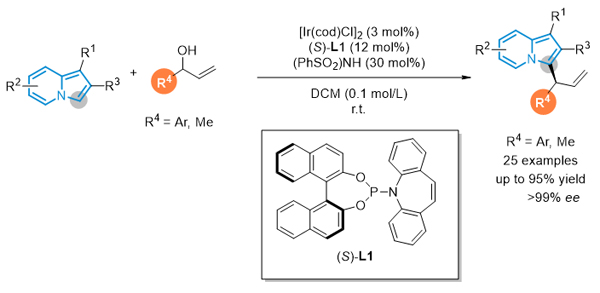摘要/Abstract

本工作报道了金属铱催化烯丙醇与中氮茚衍生物Friedel-Crafts类型的不对称烯丙基取代反应. 该方法在温和条件下, 以优秀的收率以及对映选择性控制合成了一系列C3位烯丙基化的中氮茚衍生物, 为构建手性中氮茚化合物提供了一条新策略.
关键词: 铱催化, 烯丙基取代反应, 对映选择性, 中氮茚, 烯丙醇
Indolizine is an important N-containing heterocyclic nucleus and their derivatives display interesting biological activities. The development of synthetic methods towards indolizine derivatives has attracted extensive attention. Despite the rapid growth in this area, asymmetric synthesis of indolizine derivatives has been rarely reported. Ir-catalyzed asymmetric allylic substitution reaction is an efficient method for the enantioselective construction of C-C or C-X bonds, furnishing terminal olefins bearing a stereogenic center at the allylic position with excellent regio- and enantioselectivities. In this regard, various electron-rich arenes, including indoles, pyrroles, naphthols, have been applied as the nucleophiles via Friedel-Crafts type process in the allylic substitution reactions. As a class of constitutional isomers of indoles, indolizines are now demonstrated as suitable nucleophiles in transition-metal-catalyzed allylic substitution reactions. Herein, an iridium- catalyzed enantioselective allylic substitution of allylic alcohol with indolizine is reported. A broad range of 3-allylindolizines were accessed with high yields (83%~95%) and excellent enantioselectivities (95%~>99%ee). A general procedure for the asymmetric allylation of indolizines is described in the following: A flame-dried Schlenk tube was cooled to room temperature and filled with argon. To this flask were added [Ir(cod)Cl]2 (4.0 mg, 0.006 mmol, 3 mol%) and (S)-L1 (12.1 mg, 0.024 mmol, 12 mol%). After the flask was evacuated and refilled with argon for three times, freshly distilled dichloromethane (DCM) (2 mL) were added. After the mixture was stirred for 15 min at room temperature, indolizines (0.2 mmol, 1.0 equiv.), allylic alcohols (0.4 mmol, 2.0 equiv.) and (PhSO2)2NH (18.0 mg, 0.06 mmol, 30 mol%) were added under argon atmosphere. The reaction mixture was stirred at room temperature and monitored by thin-layer chromatography (TLC). Once indolizines were consumed, the reaction was diluted with water (5 mL), and the mixture was extracted with EtOAc (10 mL×3). The organic layer was collected, dried over Na2SO4 and then concentrated in vacuo to afford the crude product. This crude material was purified by column chromatography to afford the product.
Key words: iridium-catalyzed, allylic substitution reaction, enantioselectivity, indolizine, allylic alcohol
PDF全文下载地址:
点我下载PDF
